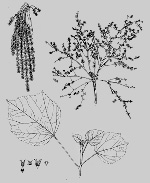 |
This is a fairly small family with a few species in western North America and from India and Asia Minor through Malesia to northern Australia, where the single species is found in dry rainforests and gallery forests on Cape York Peninsula.
Characteristic features of the family Datiscaceae in Australia include: - dry-season deciduous tree with buttressed trunk and large, spreading surface roots
- leaves alternate, simple, with long petioles
- flowers small, unisexual (the sexes on different plants) with a 4-lobed cup-shaped calyx and no petals, the males with 4 stamens, the females with an inferior ovary and 4 free styles
- fruit a small capsule with 8 or 10 prominent veins
Description
Evergreen trees. Internal secretions not obvious. Plants with simple, non-glandular, unicellular hairs. Leaves alternate and spiral, petiolate. Stipules absent. Lamina simple, symmetric, lanceolate, ovate or orbicular; base cordate; margins entire or dentate, ±flat; venation pinnate, or palmate, with the midrib conspicuous, and the tertiary venation reticulate; surfaces not punctate; herbaceous. Male and female flowers on separate plants. Inflorescences terminal, consisting of spikes or panicles. Bracts present. Pollination by wind. Flowers sessile or stalked. Floral disc absent; nectaries absent. Perianth regular, of 1 whorl only, with 4 (–5), fused, sepaloid segments, valvate in bud, tube cup-shaped or bell-shaped, green, herbaceous. Fertile stamens 4, opposite to and free of the perianth, free of the ovary and style, distinct from each other, all ±equal. Anthers dorsifixed, versatile, opening outwards by longitudinal slits; 2-celled. Ovary inferior. Carpels 3–8, fused; ovary with 1 locule. Style terminal, single and unbranched, or branching from the base. Ovules numerous, sessile; placentation parietal. Fruit a dry, dehiscent denticidal capsule; the perianth on the maturing fruit dry and persistent. Disseminule micro-surface ±reticulate, orange or brown, glossy. Seeds numerous per fruit. Aril absent. Cotyledons 2. Embryo straight.
(Note: this description has been generated from the coded data compiled for the key. Any errors in the key data will be reflected in the descriptions.)
A treatment of the family Datiscaceae has been published in:
Flora of Australia 8: 199-200.
Australian genera of Datiscaceae (as recognised for the Flora of Australia)
Tetrameles

|
  |

Tetrameles nudiflora
|
 |
|